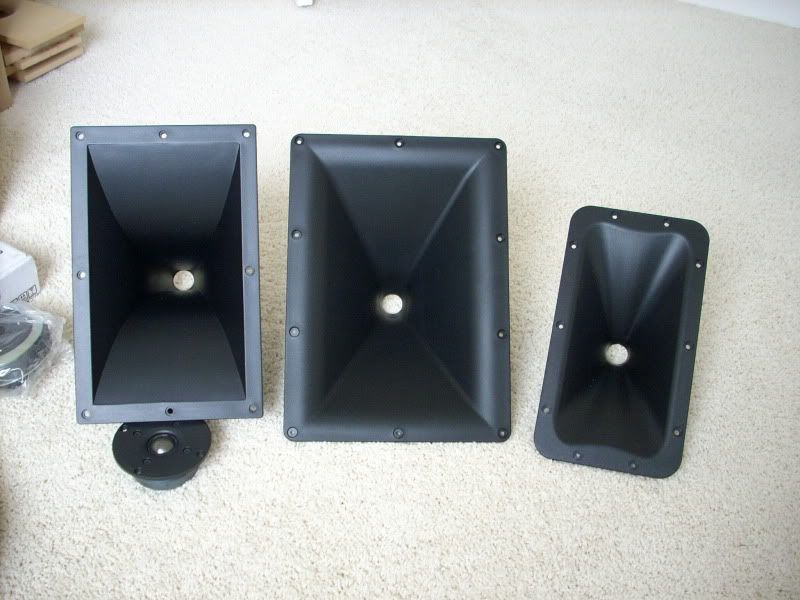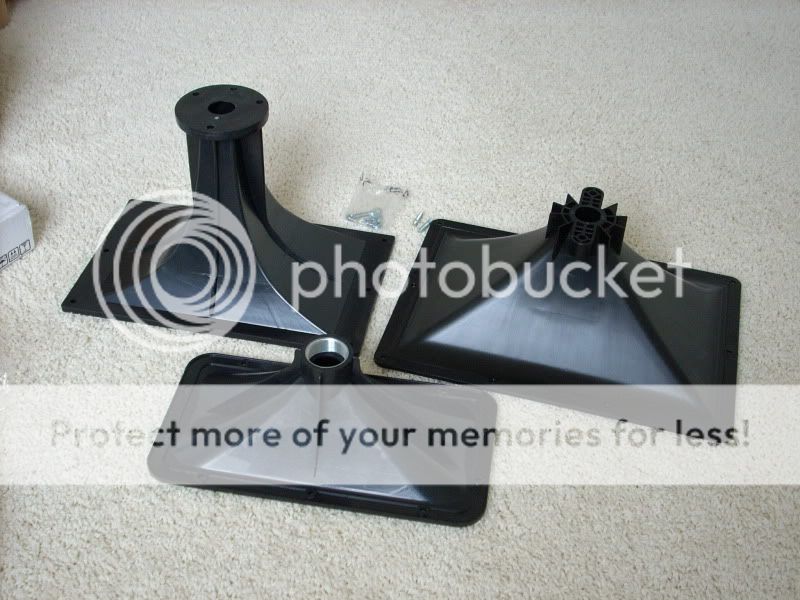noah katz said:"Someone asked earlier how come the Big Boys aren't using OS, if it's so good. It's not NIH syndrome, clearly"
Clearly, based on...?
The fact that JBL has been successfully selling OS in their products (and trademarked "EOS") since before Geddes himself even started, maybe?
ZilchLab said:
The fact that JBL has been successfully selling OS in their products (and trademarked "EOS") since before Geddes himself even started, maybe?
1: Your statement implies that Geddes didn't come up with the idea. As noted previously, it wasn't patentable. And anyone can trademark anything. That doesn't prove anything.
2: Didn't the moderators ask you to take a break from this thread for a week?
Robh3606 said:"I wonder what size this wave guide was. My guess would be half the size it is on the Summas."
So are we talking the depth so wavelength dependent as a function of waveguide depth?? When they match we get a dip??
Rob🙂
You bring up a good point. We all know that an elliptical waveguide would reduce the dip on axis. But the depth affects things too. For instance, a 90 degree waveguide will have a radius of approximately 7.5", and a depth that's comparable.
(It won't be exactly 7.5" because of the throat diameter. But it will be very close.)
Based on that, narrowing or widening the coverage angle slightly could smooth the response. Perhaps an elliptical waveguide that's 80degrees x 60 degrees?
The 18Sound XT1086, which is very flat, is 80x60.
Patrick Bateman said:
Based on that, narrowing or widening the coverage angle slightly could smooth the response. Perhaps an elliptical waveguide that's 80degrees x 60 degrees?
I like the looks of the QSC 90x60 in the middle, sorta the big brother of the econowave on the right. The pics are from augerpro; he got one for his measurement marathon. After I saw the pics and read his description of the build quality and the smoothness of the throat transition, I decided to beat the rush and ordered 8 of them from QSC for a whopping grand total of $72.30 including shipping. 😀


Patrick Bateman said:
You bring up a good point. We all know that an elliptical waveguide would reduce the dip on axis. But the depth affects things too. For instance, a 90 degree waveguide will have a radius of approximately 7.5", and a depth that's comparable.
(It won't be exactly 7.5" because of the throat diameter. But it will be very close.)
Based on that, narrowing or widening the coverage angle slightly could smooth the response. Perhaps an elliptical waveguide that's 80degrees x 60 degrees?
The 18Sound XT1086, which is very flat, is 80x60.
There are two factor to the "DIP" (or whatever Zilch wants to call it since he likes to twist things arround based on words).
First, the wavefront at the mouth has to be coherent and virtually perfectly spherical. Any deviation from this will smear the dip making it invisible. For example a small bump along the sides of the waveguide to "trip up" the wave will virtually elliminate the dip. Of course this makes for more HOM and potentially a worse sounding device, but the dip is gone.
Second the dip depends on the size of the mouth. As the mouth gets larger the dip will get shallower and lower in frequency, until at a large enough mouth it will disappear even for a circular mouth. For a 90 x 90 waveguide this would be about 18-20".
An elliptical waveguide will have a smeared dip that will be shallower and broader depending on eccentricity but will still move lower and shallower with size.
gedlee said:
There are two factor to the "DIP" (or whatever Zilch wants to call it since he likes to twist things arround based on words).
If the standard is "flat," then "dip" is clearly less pejorative than "hole."
They should probably be analyzed in terms of "Q." Toole teaches that a low-Q broadband anomaly is rather more insidious with respect to audibility and and adversely affecting sonic quality, in which context, assuming shallower is better may lead to an erroneous conclusion....
catapult said:
I like the looks of the QSC 90x60 in the middle, sorta the big brother of the econowave on the right. The pics are from augerpro; he got one for his measurement marathon. After I saw the pics and read his description of the build quality and the smoothness of the throat transition, I decided to beat the rush and ordered 8 of them from QSC for a whopping grand total of $72.30 including shipping. 😀


Haha, QSC has entered the game 😀
seems like a no brainer to order some of the larger QSC ones if all reports indicate that there is little throat difraction.
markus76 said:That's correct but do we have any data on what Q at which frequency is tolerable?
Best, Markus
http://www.provide.net/~djcarlst/abx_crit.htm
Thanks jcx. Do you know what type of signal was used? What's the title of Clark's AES paper from which the picture is taken from?
Best, Markus
Best, Markus
ZilchLab said:Toole teaches that a low-Q broadband anomaly is rather more insidious with respect to audibility and and adversely affecting sonic quality,
Thats in regard to a peak or resonance, not a dip and its more the area under the curve not just the "Q". Once again, lets not forget that no one listens on axis so the data being discussed here does not apply.
gedlee said:
Once again, lets not forget that no one listens on axis so the data being discussed here does not apply.
No one who adheres to your recommendation as to how to use your waveguides, certainly, and no one who perceives their on-axis response anomaly as an audible "defect" (independent of whether it actually is, or not), perhaps, but, as we discussed a year ago, in terms of garnering broader product acceptance, mitigating it would appear to be a worthy pursuit.
I'll spare everyone the editorialization, but while there may be reason for some to hope it can't be done, all posturing aside, count me in the group that is pleased to see you acknowledging and attending to this issue.... 😎
ZilchLab said:No one who adheres to your recommendation as to how to use your waveguides, certainly, and no one who perceives their on-axis response anomaly as an audible "defect" (independent of whether it actually is, or not), perhaps, but, as we discussed a year ago, in terms of garnering broader product acceptance, mitigating it would appear to be a worthy pursuit.
Everyone agrees that the dip is a result of an axi-symmetrical device, and that it will be largely attenuated with an elliptical device. Dr. Geddes has acknowledged that his current choice is one of practicality, based on his experience and his design requirements. But he has also said that he will be experimenting with an elliptical device, and it's possible he may make a different choice sometime down the road. You, apparently would make a different choice now.
Zilchlab, how many times do you have to keep repeating yourself? You've made your point. But it's getting very tedious. Please save the bandwidth for something new of substance.
Sheldon
ZilchLab said:... pleased to see you acknowledging and attending to this issue.... 😎
I have always acknowledged its existance - it would be pointless to deny it since its in my own data. I have not and still do not acknowledge that it "needs" to be fixed. It would make you "feel better" that's clear.
Sheldon said:
Zilchlab, how many times do you have to keep repeating yourself? You've made your point. But it's getting very tedious. Please save the bandwidth for something new of substance.
A year ago, in his analysis of the JBL waveguide, which IS the topic of this thread, BTW, Earl unequivocally stated, "An elliptical waveguide would not have the axial hole" in comparative defense of his OS design.
Now, pressed on the issue, he concedes that he overstated this point, but seeks to minimize its import, indeed, to dismiss it, with the patently absurd assertion that "... no one listens on axis so the data being discussed here does not apply."
The matter is certainly substantive, and most decidedly on topic. Much as he might like it to be otherwise, Earl's "I don't listen on-axis" workaround is not mainstream, and the JBL waveguide does not exhibit this anomaly....
I said NEW and substantive. New, this is not. None of it. I get it. I'm guessing everyone gets it. Buy hey, I'll go ahead and make the last word yours, for the umteenth time.
Sheldon
Sheldon
ZilchLab said:
Earl's "I don't listen on-axis" workaround is not mainstream,
Beg to differ. The concept of axes crossed in front of the listener has been commonplace common sense for many decades. Ted Jordan strongly advocated as far back in the mid 50's, and he wasn't the first to advocate it.
ZilchLab said:and the JBL waveguide does not exhibit this anomaly....
some of them do:
http://www.jblpro.com/catalog/support/getfile.aspx?doctype=3&docid=1078
see "Horizontal Off-Axis Frequency Response" on page 2, aligned for 0dB on axis. The 10° curve is louder than the 0° curve around 12khz
But I think you know this PT waveguide very well for having tried it yourself.
This is the PT wave guide I am going to use as a tweeter with a 2407H above 8khz.
By the way, thanks Zilch for having pointed this waveguide to me on audioheritage.org !
ZilchLab said:
A year ago, in his analysis of the JBL waveguide, which IS the topic of this thread, BTW, Earl unequivocally stated, "An elliptical waveguide would not have the axial hole" in comparative defense of his OS design.
Now, pressed on the issue, he concedes that he overstated this point,
Exactly where did I do that?
Are you quibly with "would not have" and "substantially elliminated" or "minimized" becaues that is very petty indeed. Its a sign of a bankrupt argument when one has to resort to those kinds of insignificant distinctions.
pooge said:
Beg to differ. The concept of axes crossed in front of the listener has been commonplace common sense for many decades. Ted Jordan strongly advocated as far back in the mid 50's, and he wasn't the first to advocate it.
Thank you for this, but I believe we have already established that this is not a Geddes innovation; he has told us so himself. Fact is, this trompe l'oreille works better with constant directivity HF sources, but best with the defined directivity horns JBL designed and marketed for the purpose, as I posted above.
By "not mainstream," I did not mean not known, rather, that it is only infrequently practiced at home, and has limited applicability in sound reinforcement.
pos said:
some of them do:
http://www.jblpro.com/catalog/support/getfile.aspx?doctype=3&docid=1078
see "Horizontal Off-Axis Frequency Response" on page 2, aligned for 0dB on axis. The 10° curve is louder than the 0° curve around 12khz.
Oh NO, man, that is HUGE!

- Status
- Not open for further replies.
- Home
- Loudspeakers
- Multi-Way
- Horn vs. Waveguide